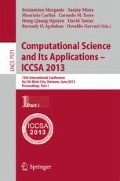Abstract
One of the critical issue of wireless sensor networks is a poor sensor battery. It leads to sensor vulnerability for battery exhausting attacks. Quick depletion of battery power is not only explained by intrusions but also by a malfunction of networks protocols. In this paper, a special type of denial-of-service attack is investigated. The intrusion effect is the depletion of sensor battery power. In contrast to general denial-of-service attack, quality of service under the considered attack is not necessarily degraded. Therefore, the application of traditional defense mechanism against this intrusion is not always possible. Taking into account proprieties of wireless sensor networks, a model for evaluation of energy consumption under the attack is described. Using this model, the attack detection method is offered.
Access this chapter
Tax calculation will be finalised at checkout
Purchases are for personal use only
Preview
Unable to display preview. Download preview PDF.
References
Ma, Y., Richards, M., Ghanem, M., Guo, Y., Hassard, J.: Air Pollution Monitoring and Mining Based on Sensor Grid in London. Sensors 8, 3601–3623 (2008)
Zhao, Y., Shouzhi, X., Shuibao, Z., Xiaomei, Y.: Distributed detection in landslide prediction based on Wireless Sensor Networks. In: Proceedings of World Automation Congress, Puerto Vallarta, Mexico, June 24-28, pp. 235–238 (2012)
Akyildiz, I.F., Su, W., Sankarasubramaniam, Y., Cayirci, E.: Wireless Sensor Networks: A Survey. Computer Networks 38, 393–422 (2002)
Istepanian, R., Jovanov, E., Zhang, Y.: Guest editorial introduction to the special section on M-Health: Beyond seamless mobility and global wireless Health-Care connectivity. IEEE Trans. Inf. Technol. Biomed. 8, 405–414 (2004)
Milenkovic, A., Otto, C., Jovanov, E.: Wireless sensor network for personal health monitoring: Issues and an implementation. Comput. Commun. 29, 2521–2533 (2006)
Junnila, S., Kailanto, H., Merilahti, J., Vainio, A.-M., Vehkaoja, A., Zakrzewski, M., Hyttinen, J.: Wireless, Multipurpose In-Home Health Monitoring Platform: Two Case Trials. IEEE Trans. Inf. Technol. Biomed. 14, 447–455 (2010)
Bachmann, C., Ashouei, M., Pop, V., Vidojkovic, M., Groot, H.D., Gyselinckx, B.: Low-power wireless sensor nodes for ubiquitous long-term biomedical signal monitoring. IEEE Commun. Mag. 50, 20–27 (2012)
Han, K., Shon, T., Kim, K.: Efficient mobile sensor authentication in smart home and WPAN. IEEE Trans. Consum. Electr. 56, 591–596 (2010)
Byun, J., Jeon, B., Noh, J., Kim, Y., Park, S.: An intelligent self-adjusting sensor for smart home services based on ZigBee communications. IEEE Trans. Consum. Electr. 58, 591–596 (2012)
Nakamura, M., Igaki, H., Yoshimura, Y., Ikegami, K.: Considering Online Feature Interaction Detection and Resolution for Integrated Services in Home Network System. In: Proceedings of the 10th International Conference on Feature Interactions in Telecommunications and Software Systems, Lisbon, Portugal, June 11-12, pp. 191–206 (2009)
Zhou, Y., Fang, Y., Zhang, Y.: Securing wireless sensor networks: a survey. IEEE Commun. Surv. Tutor. 10, 6–28 (2008)
Young, M., Boutaba, R.: Overcoming Adversaries in Sensor Networks: A Survey of Theoretical Models and Algorithmic Approaches for Tolerating Malicious Interference. IEEE Commun. Surv. Tutor. 13, 617–641 (2011)
Chen, X., Makki, K., Yen, K., Pissinou, N.: Sensor network security: a survey. IEEE Commun. Surv. Tutor. 11, 52–73 (2009)
Mpitziopoulos, A., Gavalas, D., Konstantopoulos, C., Pantziou, G.: A survey on jamming attacks and countermeasures in WSNs. IEEE Commun. Surv. Tutor. 11, 42–56 (2009)
Raymond, D., Midkiff, S.: Denial-of-Service in Wireless Sensor Networks: Attacks and Defenses. IEEE Pervasive Computing 7, 74–81 (2007)
Sun, J., Fang, Y., Zhu, X.: Privacy and emergency response in e-healthcare leveraging wireless body sensor networks. IEEE Wireless Communications 17, 66–73 (2010)
Buttyan, L., Csik, L.: Security analysis of reliable transport layer protocols for wireless sensor networks. In: Proceedings of the 8th IEEE International Conference on Pervasive Computing and Communications Workshops (PERCOM Workshops 2010), pp. 419–424 (April 2010)
Brownfield, M., Gupta, Y., Davis, N.: Wireless sensor network denial of sleep attack. In: Proc. 6th Annu. IEEE SMC Inform. Assurance Workshop, pp. 356–364 (2005)
Khouzani, M., Sarkar, S.: Maximum damage battery depletion attack in mobile sensor networks. IEEE Trans. Autom. Control 56(10), 2358–2368 (2011)
Khouzani, M., Sarkar, S., Altman, E.: Maximum damage malware attack in mobile wireless networks. IEEE/ACM Transactions on Networking 20(5), 1347–1360 (2012)
Shakhov, V.V., Choo, H., Bang, Y.: Discord model for detecting unexpected demands in mobile networks. Future Generation Comp. Syst. 20(2), 181–188 (2004)
Author information
Authors and Affiliations
Editor information
Editors and Affiliations
Rights and permissions
Copyright information
© 2013 Springer-Verlag Berlin Heidelberg
About this paper
Cite this paper
Shakhov, V.V. (2013). Protecting Wireless Sensor Networks from Energy Exhausting Attacks. In: Murgante, B., et al. Computational Science and Its Applications – ICCSA 2013. ICCSA 2013. Lecture Notes in Computer Science, vol 7971. Springer, Berlin, Heidelberg. https://doi.org/10.1007/978-3-642-39637-3_15
Download citation
DOI: https://doi.org/10.1007/978-3-642-39637-3_15
Publisher Name: Springer, Berlin, Heidelberg
Print ISBN: 978-3-642-39636-6
Online ISBN: 978-3-642-39637-3
eBook Packages: Computer ScienceComputer Science (R0)

